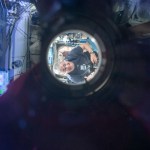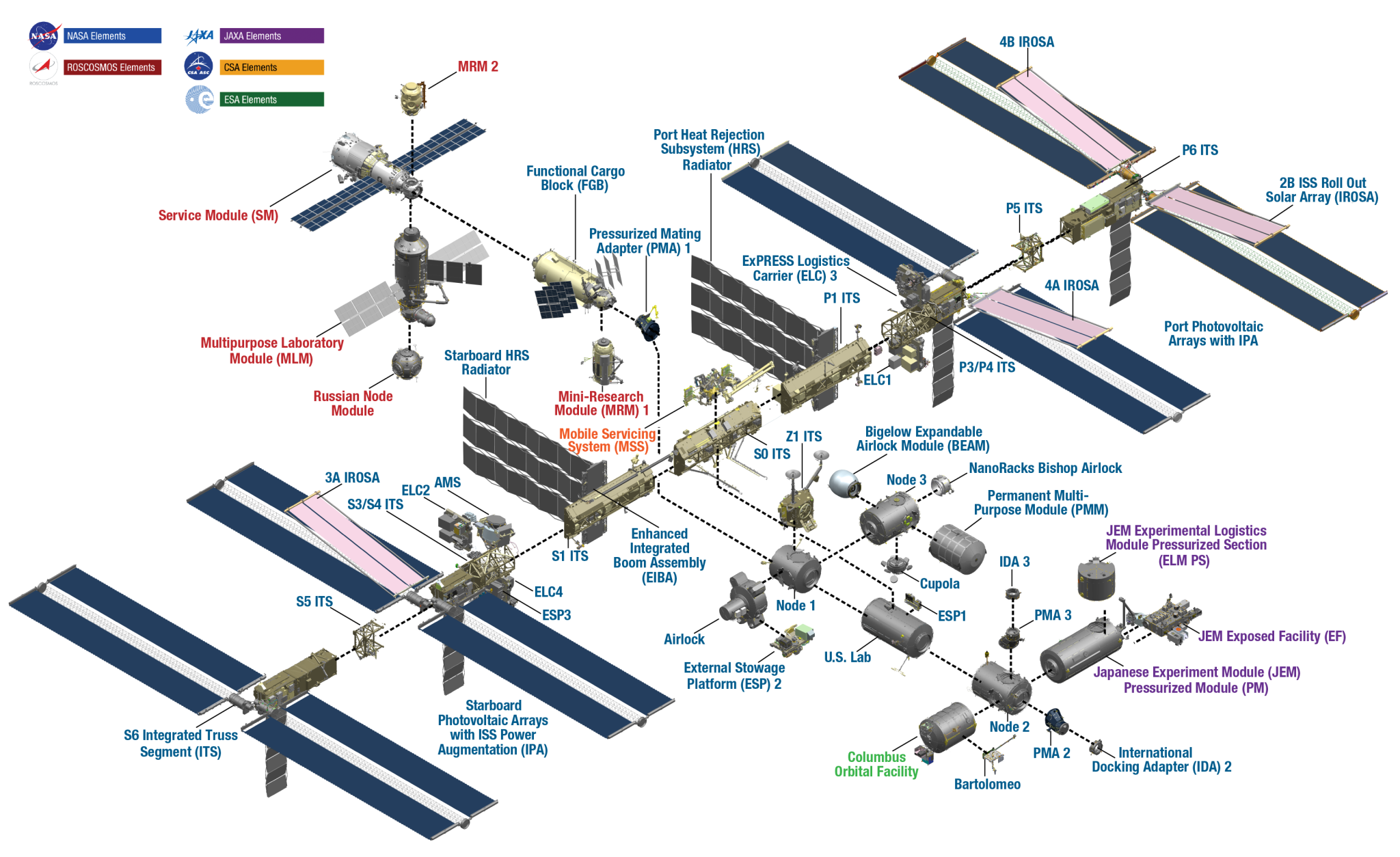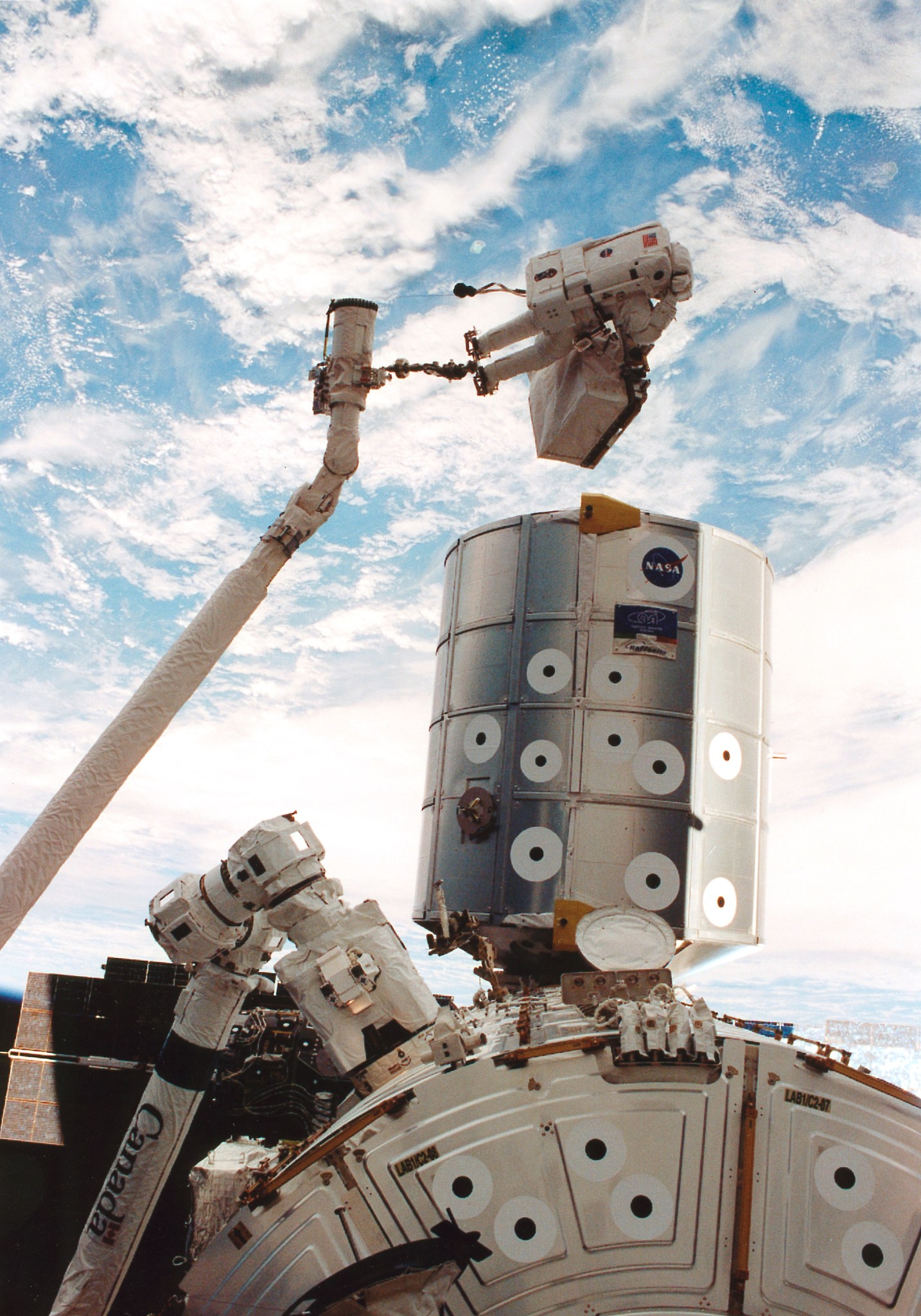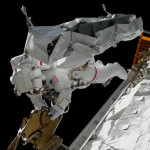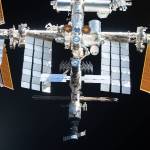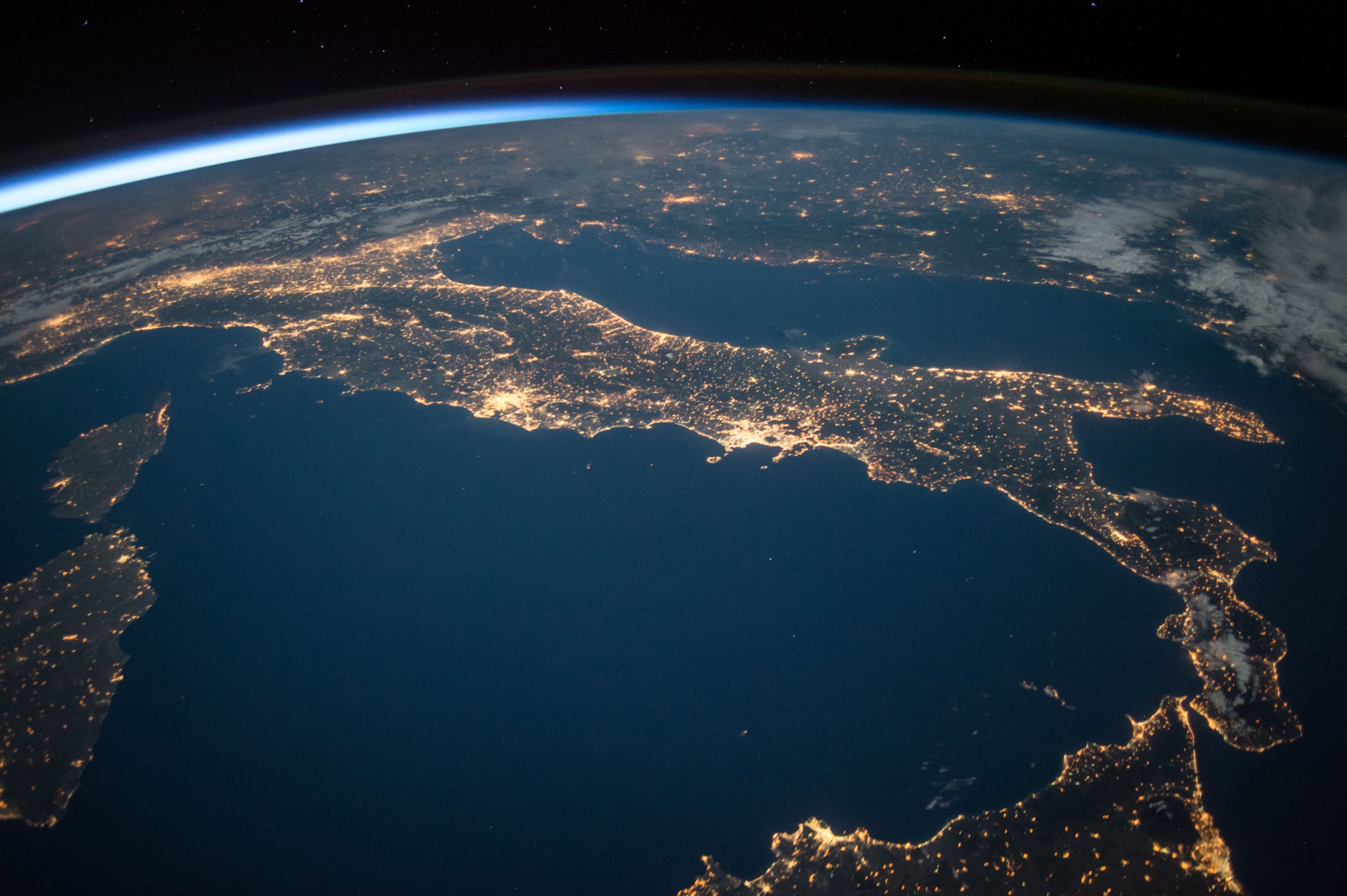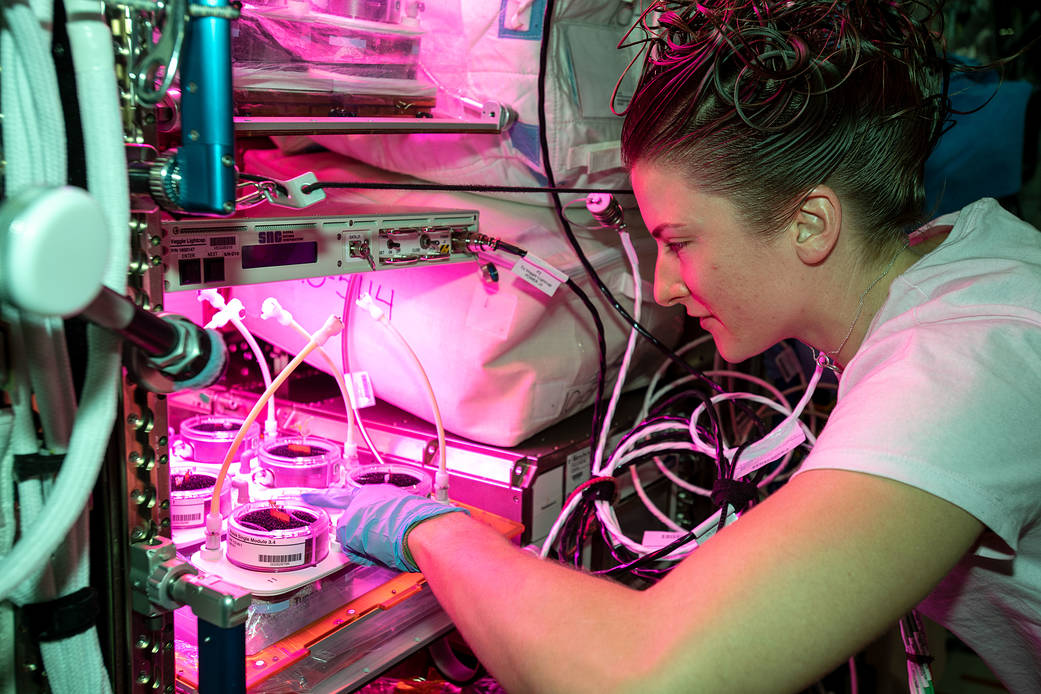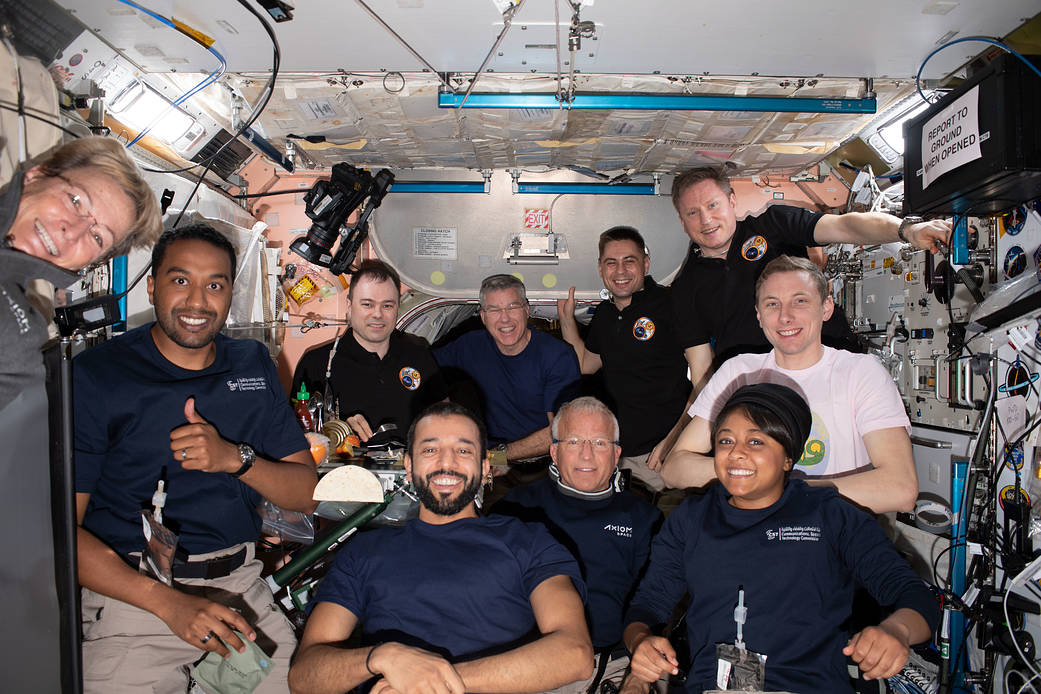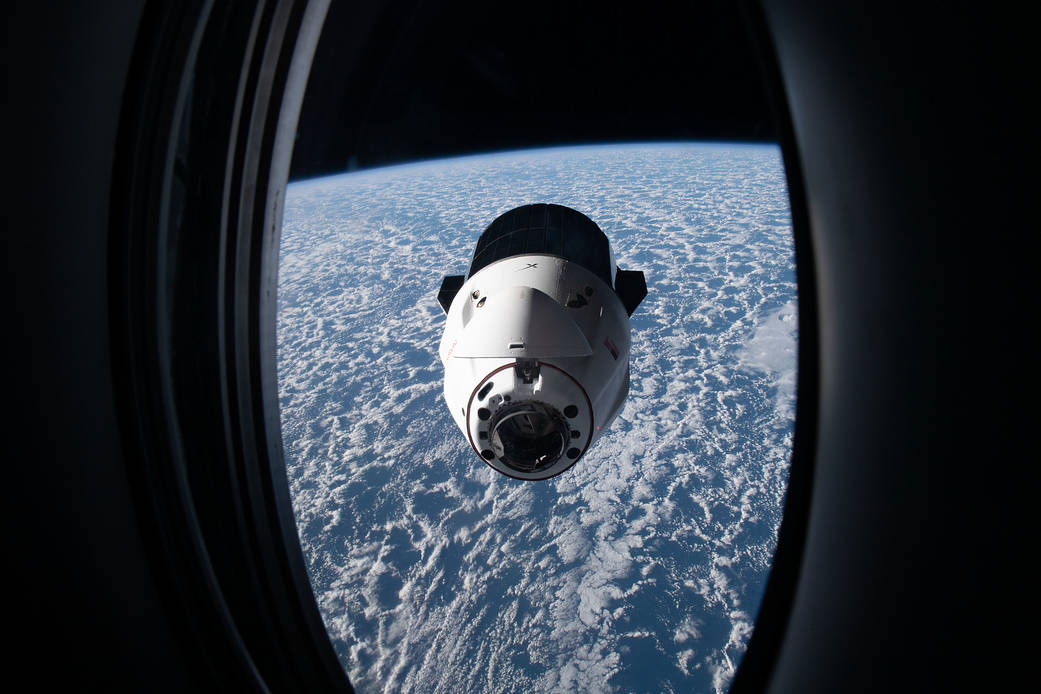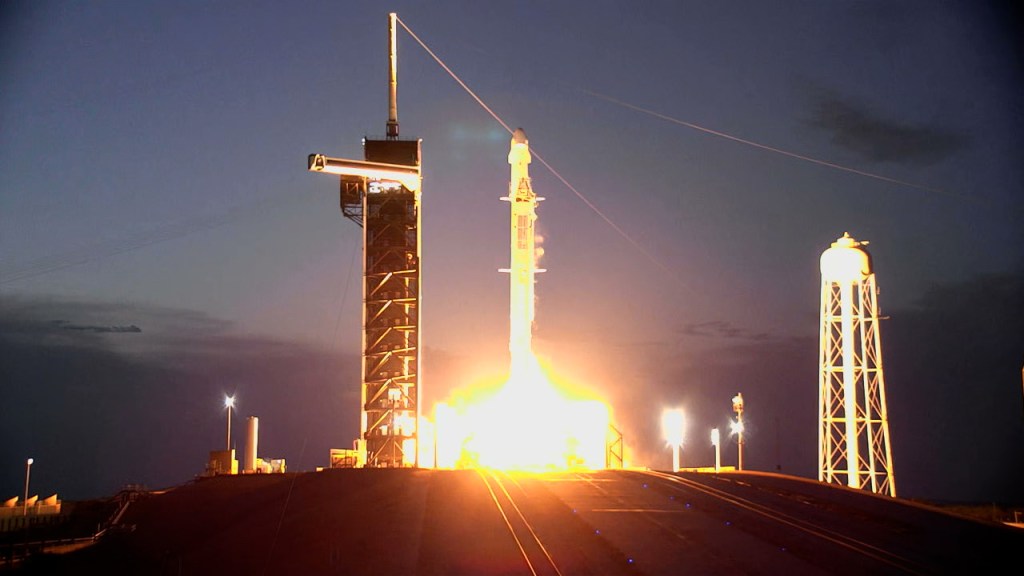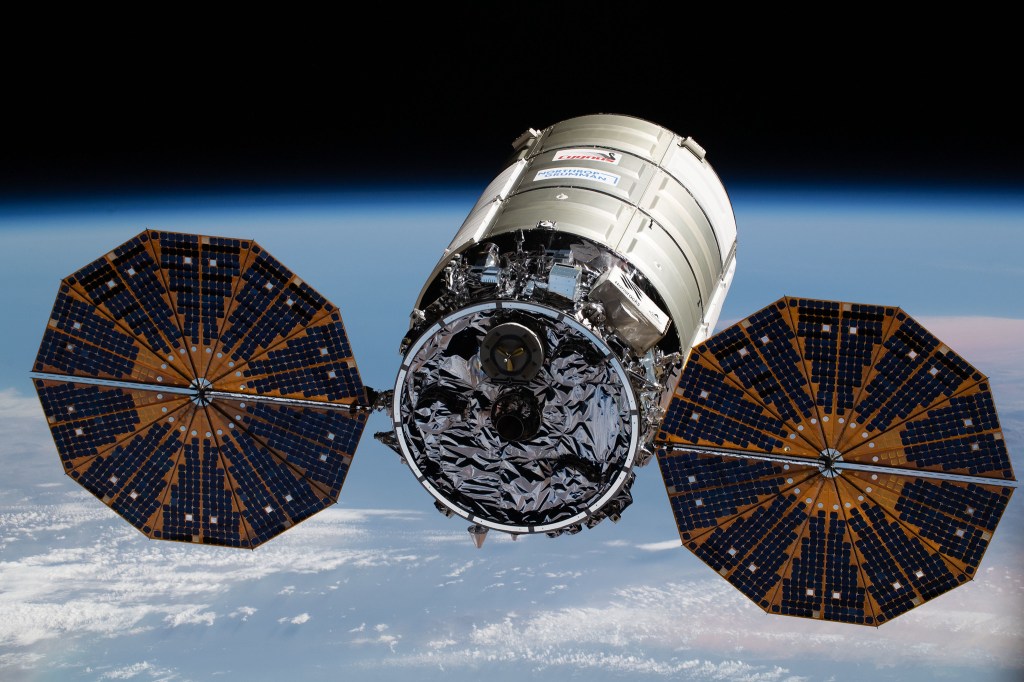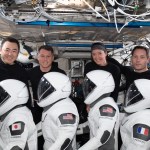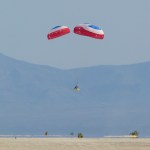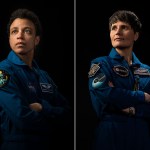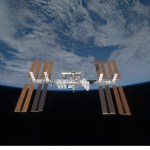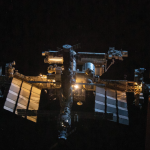International Space Station
The International Space Station Program brings together international flight crews, multiple launch vehicles, globally distributed launch and flight operations, training, engineering, and development facilities, communications networks, and the international scientific research community.
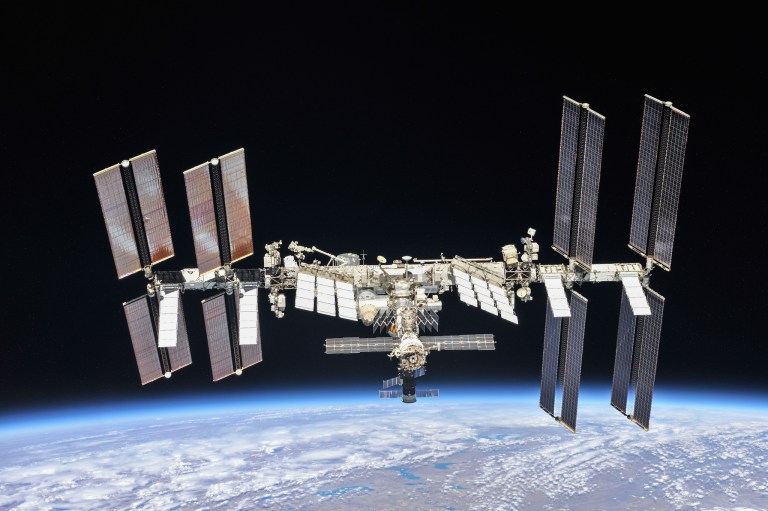
Overview
The Space Station was officially given approval by President Reagan and a budget approved by the US Congress in 1984. NASA Administrator James Beggs immediately set out to find international partners who would cooperate on the program. Canadians, Japanese and many nations of the European Space Agency began to participate in the program soon after.
The Station was designed between 1984 and 1993. Elements of the Station were in construction throughout the US, Canada, Japan, and Europe beginning in the late 1980s.
In 1993, as the Station was undergoing a redesign, the Russians were invited to participate.
Agreement was made to proceed in two phases. During the first phase, NASA Space Shuttles would carry astronauts and cosmonauts to the Russian Mir Orbital Station. The US would help to modify two Russian-built modules to house US and international experiments and to establish working processes between the participating nations. During Phase 2, led by the US and Russia, all of the participating nations would contribute elements and crewmembers to a new International Space Station (ISS).
Phase 1, called NASA-Mir, took place between 1995 and 1998. Eleven Space Shuttle launches went to Mir with the last ten docking to Mir and astronauts and cosmonauts transferring between the two vehicles. Two new Russian modules, Spektr and Priroda were launched, became part of Mir, and housed dozens of US payloads and seven US astronauts.
In Phase 2, the elements of the new ISS were launched beginning in 1998.
Five partner agencies, the Canadian Space Agency, the European Space Agency, the Japan Aerospace Exploration Agency, the National Aeronautics and Space Administration, and the State Space Corporation “Roscosmos”, operate the International Space Station, with each partner responsible for managing and controlling the hardware it provides. The station was designed from the outset to be interdependent and relies on contributions from across the partnership to function. The International Space Station (ISS) is the unique blend of unified and diversified goals among the world’s space agencies that will lead to improvements in life on Earth for all people of all nations. While the various space agency partners may emphasize different aspects of research to achieve their goals in the use of the ISS, they are unified in several important overarching goals. All of the agencies recognize the importance of leveraging the ISS as an education platform to encourage and motivate today’s youth to pursue careers in math, science, engineering, and technology (STEM): educating the children of today to be the leaders and space explorers of tomorrow. All the agencies are unified in their goals to apply knowledge gained through ISS research in human physiology, radiation, materials science, engineering, biology, fluid physics, and technology: enabling future space exploration missions.
Advancing our knowledge in the areas of human physiology, biology, and material and physical sciences and translating that knowledge to health, socioeconomic, and environmental benefits on
Earth is another common goal of the agencies: returning the knowledge gained in space research for the benefit of society.
The ISS program’s greatest accomplishment is as much a human achievement as a technological one. The global partnership of space agencies exemplifies meshing of cultural differences and political intricacies to plan, coordinate, provide, and operate the complex elements of the ISS. The program also brings together international flight crews and globally distributed launch, operations, training, engineering, communications networks, and scientific research communities.
Although the primary Mission Control centers are in the US and Russia, several ancillary control centers in Canada, Japan, and Europe also have a role in managing each nation’s elements and crew members.
The intended life span of ISS has been extended several times. Since several elements are now beyond their originally intended lifespans, analyses are conducted periodically to ensure the Station is safe for continued habitation and operation. Much of the Station is modular and so as parts and systems wear out, new parts are launched to replace or augment the original. The ISS will continue to be a working laboratory and outpost in orbit until at least 2030.
How it All Began
The idea of living in space was the very first step towards a space station. The first person to write about living and traveling in space was the noted renaissance astronomer Johannes Kepler in the early 1600s. He was the first to realize that planets were worlds, that there was space between the planets and he wrote that one day people would travel through space.
In the 1860s, Edward Everett Hale wrote the “Brick Moon” which was published in the Atlantic Weekly magazine. The Brick Moon had many of the characteristics of a space station; it was a man-made structure that orbited Earth and provided housing and life support for its crew while serving as a navigation aid for people on Earth.
Others, like the Russian theoretician Konstantin Tsiolkovsky were thinking about designs for space stations that could use sunlight for power and that would serve as miniature Earths, with growth of vegetation in the interior.
The first details of the engineering, design and construction of a space station were described by Herman Noordung, in 1928. He described a “wohnrad” or “living wheel“; a wheel shaped rotating space station. He reasoned that the rotation would be required to create artificial gravity for the crewmembers. He described how it would be assembled first on the ground for testing and then its individual parts launched by rocket for reassembly in orbit.
Willy Ley wrote about life in a space station in 1952. “When man first takes up residence in space, it will be within the spinning hull of a wheel-shaped space station [revolving] around the earth much as the moon does. Life will be cramped and complicated for space dwellers; they will exist under conditions comparable to those in a modem submarine…it will be a self-contained community in which all man’s needs, from air-conditioning to artificial gravity, have been supplied.” [Willy Ley and Chesley Bonestell in The Conquest of Space, Viking Press.] Their ideas went nationwide in Collier’s Magazine and on the Walt Disney television program.
The US government began to develop space station concepts in the 1950s. One of the early concepts was the US Army Project Horizon modular orbital station which would serve to house crews and refuel spacecraft on their way to a moon base. In the early 1960s, NASA’s Manned Spacecraft Center (now Johnson Space Center in Houston) elaborated on the requirements for a station and they patented the concept. Concepts for the first US space station, which would later become known as Skylab, started about this time.
Almost simultaneously, the Soviet Union planned a super rocket launcher that would orbit a large space station. The rocket, designated the N-1, would also be pressed into service for the Soviet manned Moon landing program. But test launches beginning in 1969 proved unsuccessful and so the Soviets turned their attention to smaller stations which could be launched by their most powerful functioning rocket, the Proton.
Assembly
The ISS components were built in various countries around the world, with each piece performing once connected in space, a testament to the teamwork and cultural coordination.
Like a Lego set, each piece of the ISS was launched and assembled in space, using complex robotics systems and humans in spacesuits connecting fluid lines and electrical wires.
The ISS is the largest humanmade object ever to orbit Earth. ISS has a pressurized volume of approximately 900 m3 (31,000 ft3) and a mass over 400,000 kg (900,000 lbs). Actual numbers vary as logistics resupply vehicles come and go on a frequent and regular basis.
The ISS solar arrays cover an area of 2,247 m2 (24,187 ft2) and can generate 735,000 kW-hours of electrical power per year.
The ISS structure measures 109 m (358 ft) (across arrays) by 51 m (168 ft) (module length from the forward end of PMA2 to the aft end of the SM).
ISS orbits at an altitude of between 370–460 km (200–250 nmi). Its falls towards Earth continually due to atmospheric friction and requires periodic rocket firings to boost the orbit. The ISS orbital inclination is 51.6°, permitting ISS to fly over 90% of the inhabited Earth.
ISS carries a crew of between 3 and 13 depending on then number of people and passenger vehicles during handover periods, It continually hosts a crew of seven.
Building the ISS required 36 Space Shuttle assembly flights and 6 Russian Proton and Soyuz rocket launches. More launches are continuing as new modules are completed and ready to become part of the orbiting complex.
Logistics, resupply and crew exchange have been provided by a number of vehicles including the
Space Shuttle, Russian Progress and Soyuz, Japanese H-II Transfer Vehicle (HTV), European Automated Transfer Vehicle (ATV) and commercial Dragon, Cygnus and Starliner vehicles.
For more information about the International Space Station assembly elements visit https://www.nasa.gov/international-space-station/international-space-station-assembly-elements/.
Spacewalks
The complex assembly of space station would have been impossible without the skilled labors of spacewalking astronauts and cosmonauts. Spacewalks, or Extravehicular activity (EVA) were conducted in Earth orbit, on the Moon’s surface, and in deep space between the Earth and Moon in prior programs.
The cumulative experience of the EVAs conducted prior to the start of ISS assembly formed a solid basis on which to build the necessary spacewalking skills but during the ISS Program more spacewalks have been conducted than in all prior programs, combined. At one time ‘the wall of spacewalks‘ was seen as a formidable obstacle to assembling the ISS but spacewalks and assembly missions have proceeded almost with no hindrances.
In the two+ decades since station assembly began, more than 260 spacewalks for assembly, maintenance, and reconfiguration have been required. Spacewalks were essential to preparing the ISS to accommodate its first occupants.
Astronauts Jerry L. Ross and James H. Newman conducted the first ISS EVA on December 7, 1988, during the STS-88 mission, to connect electrical and data cables between the station’s first two modules, FGB Zarya and Node 1 Unity. Over the course of the first five shuttle assembly missions, 12 crew members conducted 10 spacewalks prior to the Expedition 1 crew taking up residence on the station. During STS-96, the second assembly mission in May 1999, Tamara E. “Tammy” Jernigan became the first woman to perform an EVA at ISS. Astronaut Edward T. “Ed” Lu and cosmonaut Yuri I. Malenchenko conducted the first U.S.-Russian EVA at station during the June 2000 STS-101 mission. The two connected electrical and data cables between FGB Zarya and the newly arrived Service Module Zvezda. In preparation for that spacewalk Russian engineers modified the Hydrolab facility at the Gagarin Cosmonaut Training Center to accommodate the U.S. EMU spacesuits. American engineers adapted the Neutral Buoyancy Laboratory at NASA’s Johnson Space Center to accommodate the Expedition 1 crew train using either the US EMU or Russian Orlan spacesuits.
Following the arrival of Expedition 1 crew members William M. Shepherd, Yuri P. Gidzenko and Sergei K. Krikalev aboard the space station on Nov. 2, 2000, the pace of assembly and the number of spacewalks increased significantly. Between December 2000 and April 2003, 38 astronauts and cosmonauts completed 41 EVAs, including the first staged from station itself, using an ISS airlock, rather than from the visiting Space Shuttle. On March 10, 2001, Expedition 2 astronauts James S. Voss and Susan J. Helms conducted a spacewalk during STS-102 that, at eight hours and 56 minutes, still stands as the longest EVA in history. In April 2001, Canadian Space Agency astronaut Chris A. Hadfield became the first Canadian to conduct a spacewalk at the orbiting laboratory during STS-100, the flight that brought the Canadarm2 robotics system to the space station. On June 8, Voss joined Expedition 2 cosmonaut Yuri V. Usachev for the first Russian segment EVA, an ‘internal’ spacewalk inside Zvezda’s Transfer Compartment to prepare it for the arrival of a new module.
The STS-104 mission in July 2001 brought the US-built Quest ‘Joint’ Airlock to the station, providing station a standalone EVA capability with accommodations for either the U.S. Extravehicular Mobility Unity (EMU) or Russian Orlan suits. Michael L. Gernhardt and James F. Reilly performed the first EVA from Quest on July 20. The Russian Pirs (Pier) module arrived at station on Sept. 17, 2001, providing the Russian segment with its own airlock capability. On Oct. 8, Expedition 3 cosmonauts Vladimir N. Dezhurov and Mikhail V. Tyurin staged the first EVA from Pirs.
Along with American and Russian crewmates, international partners continued to play a role in spacewalking, with Philippe Perrin becoming the first astronaut from France to perform a spacewalk at station during the STS-111 mission in June 2002.
Following the Space Shuttle Columbia accident, station spacewalks continued, but only from the Russian segment with the added complication that with the resident crew size was reduced to two, the pair of spacewalking crew members left no one inside to monitor its systems. Although this posed a slightly increased risk should something go wrong, these “two-person” spacewalks proved essential during the shuttle hiatus. Expedition 8 crew members Aleksandr Y. Kaleri and Mike Foale conducted the first of these EVAs on Feb. 26, 2004. Foale had prior experience with the Orlan suit, as he had completed an EVA during his long-duration stay aboard Mir in 1997. The crew had to cut the spacewalk short due to Kaleri’s suit overheating and water droplets forming inside his helmet. The crew later identified the problem as a kink in the water line in his liquid cooling garment. The incident provided a preview of a more serious problem, which would occur in an EMU during an EVA more than nine years later.
On the STS-114 shuttle Return to Flight mission, Soichi Noguchi became the first astronaut from the Japan Aerospace Exploration Agency (JAXA) to conduct an EVA at station on July 30, 2005. The first ESA (European Space Agency) astronaut to perform a station spacewalk was Expedition 13 crew member Thomas A. Reiter from Germany on Aug. 3, 2006.
Although all spacewalks carry a certain amount of risk, two examples illustrate how some are riskier than others. The objectives of the STS-120 mission in October 2007 included not only the delivery of the Harmony module to station, but also the relocation of the P6 truss segment from its location atop the Z1 truss, where it had been since December 2000, to the outboard port-side truss. During the overall reconfiguration of the station’s power systems earlier in 2007, the P6’s solar arrays were rolled up. After the crew members relocated P6 to the outboard truss, they began to unfurl the two arrays. The first array opened without incident, but with the second array nearly unfurled, the astronauts noticed a tear in a small portion of the panel and immediately halted the deployment to prevent further damage. Working with the crew aboard, mission managers devised a plan to have one of the astronauts essentially suture the tear in the panel. Appropriately enough, one of the two STS-120 spacewalkers, Scott E. Parazynski, was also a physician, and he put his suturing skills to good use. Attached to a portable foot restraint, Parazynski was hoisted atop not only the station’s robotic arm, but also the shuttle’s boom normally used to inspect the shuttle orbiter’s tiles — the impromptu arrangement providing just enough reach for Parazynski to successfully repair the torn array using improvised “cufflinks.” After he secured five cufflinks to the damaged panel, crew members inside the station fully extended the array as Parazynski monitored the event.
For more information about spacewalks visit https://www.nasa.gov/international-space-station/space-station-spacewalks/.
International Cooperation
The International Space Station (ISS) Program’s greatest accomplishment is as much a human achievement as it is a technological one—how best to plan, coordinate, and monitor the varied activities of the Program’s many organizations.
An international partnership of space agencies provides and operates the elements of the ISS. The principals are the space agencies of the United States, Russia, Europe, Japan, and Canada. The ISS has been the most politically complex space exploration program ever undertaken.
For more information about international cooperation visit https://www.nasa.gov/international-space-station/space-station-international-cooperation/.
Research and Science
The International Space Station is an unprecedented achievement in global human endeavors to build and utilize a research platform in space. Since 2000, the station evolved from an outpost into a highly capable microgravity laboratory.
In its third decade of continuous human presence, the International Space Station has a far-reaching impact as a microgravity lab hosting technology, demonstrations, and scientific investigations from a range of fields. Results are compounding and new benefits are emerging.
For more information about the research conducted on the International Space Station visit https://www.nasa.gov/international-space-station/space-station-research-and-technology/.
Expeditions
The International Space Station has been continuously inhabited for over 20 years beginning with Expedition 1 when it docked on November 2, 2000, when it was just three modules. The orbiting laboratory has expanded to the size of a football field hosting over 260 individuals from 21 countries comprising over 60 Expeditions. The orbital outpost will continue to provide advanced research benefitting humans on and off the Earth through 2030.
For more information about expeditions to the International Space Station visit https://www.nasa.gov/international-space-station/expedition-missions-content-list/.
Commercial Space
NASA is developing a human spaceflight economy enabled by a commercial market. To achieve that goal, NASA is committed to developing a robust low Earth orbit economy and enabling both the supply side and the demand side. The low Earth orbit economy is a new and growing market of private companies providing access to, and services in, space. Customers include NASA, other government agencies, academic and research-based institutions, and other private companies.
For more information about commercial space visit https://www.nasa.gov/humans-in-space/commercial-space/.
Space Shuttle Crews
The Space Shuttle was the world’s first reusable spacecraft, and the first spacecraft in history that can carry large satellites both to and from orbit. The Shuttle launches like a rocket, maneuvers in Earth orbit like a spacecraft and lands like an airplane. Each of the three Space Shuttle orbiters now in operation — Discovery, Atlantis and Endeavour — is designed to fly at least 100 missions. So far, altogether they have flown a combined total of less than one-fourth of that.
Columbia was the first Space Shuttle orbiter to be delivered to NASA’s Kennedy Space Center, Fla., in March 1979. Columbia and the STS-107 crew were lost Feb. 1, 2003, during re-entry. The Orbiter Challenger was delivered to KSC in July 1982 and was destroyed in an explosion during ascent in January 1986. Discovery was delivered in November 1983. Atlantis was delivered in April 1985. Endeavour was built as a replacement following the Challenger accident and was delivered to Florida in May 1991. An early Space Shuttle Orbiter, the Enterprise, never flew in space but was used for approach and landing tests at the Dryden Flight Research Center and several launch pad studies in the late 1970s.
For more information about the Space Shuttle era visit https://www.nasa.gov/space-shuttle/.

Commercial Crew Program
NASA’s Commercial Crew Program is delivering on its goal of safe, reliable, and cost-effective human transportation to and from the International Space Station from the United States through a partnership with American private industry.
NASA’s Commercial Crew Program has worked with several American aerospace industry companies to facilitate the development of U.S. human spaceflight systems since 2010. The goal is to have safe, reliable and cost-effective access to and from the International Space Station and foster commercial access to other potential low-Earth orbit destinations.
For more information about the Commercial Crew Program visit https://www.nasa.gov/humans-in-space/commercial-space/commercial-crew-program/.
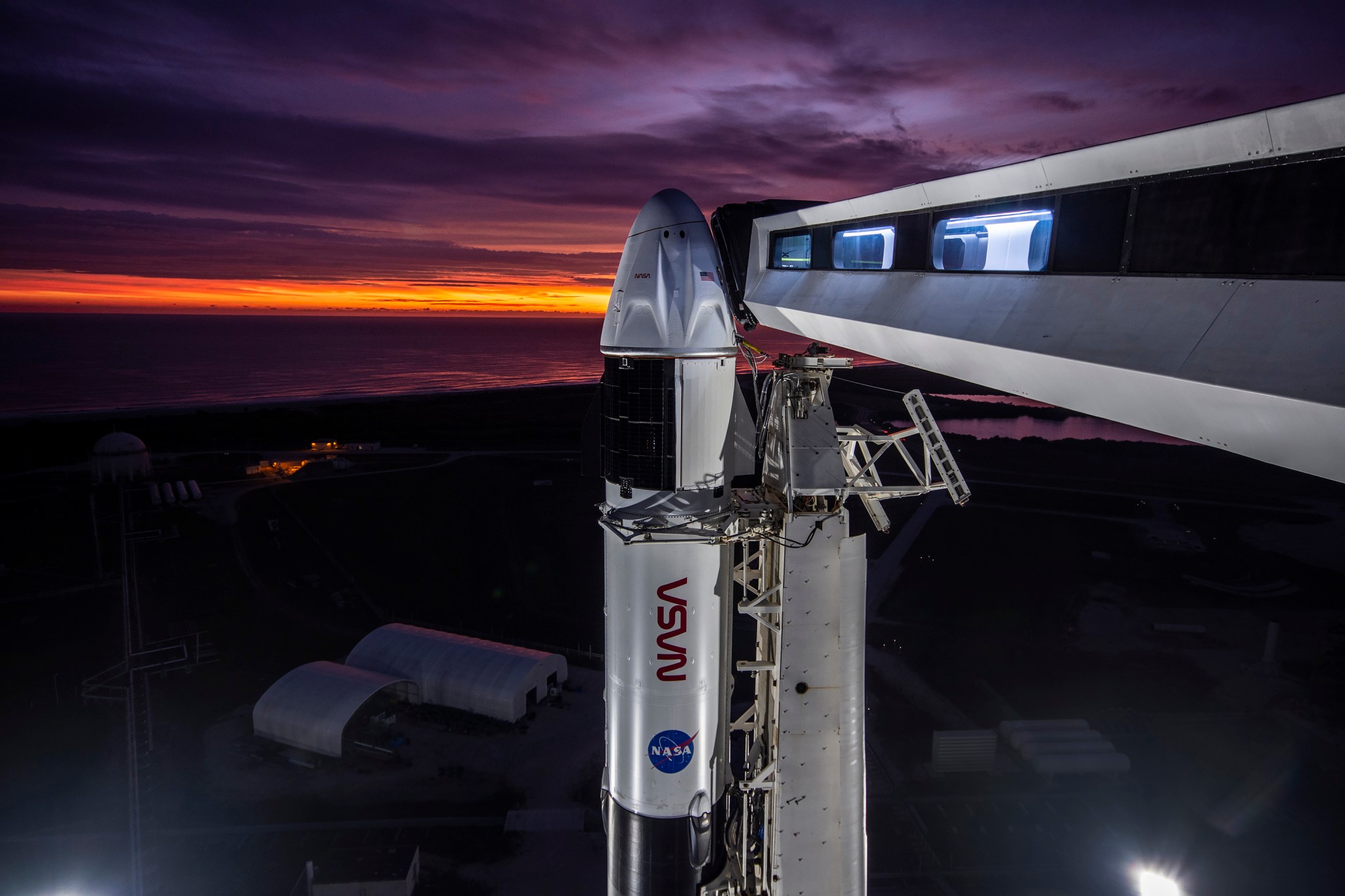
Current Management
Dana Weigel, manager, NASA’s International Space Station Program
Dina Contella, deputy manager, NASA’s International Space Station Program
Bill Spetch, operations integration manager, NASA’s International Space Station Program
Melissa Gard, chief of staff, NASA’s International Space Station Program
Transition
The International Space Station is a unique laboratory that is returning enormous scientific, educational, and technological developments to benefit people on Earth and is enabling our ability to travel into deep space. The Biden-Harris Administration’s commitment to extend space station operations until 2030 will enable the United States to continue to reap these benefits for the next decade while U.S. industry develops commercial destinations and markets for a thriving space economy.
As NASA looks forward to a decade of results from research and technology development aboard the International Space Station, the agency is taking steps to ensure a successful transition of operations to commercial services.
Learn more about the International Space Station transition plan through this article and the transition FAQs.


























